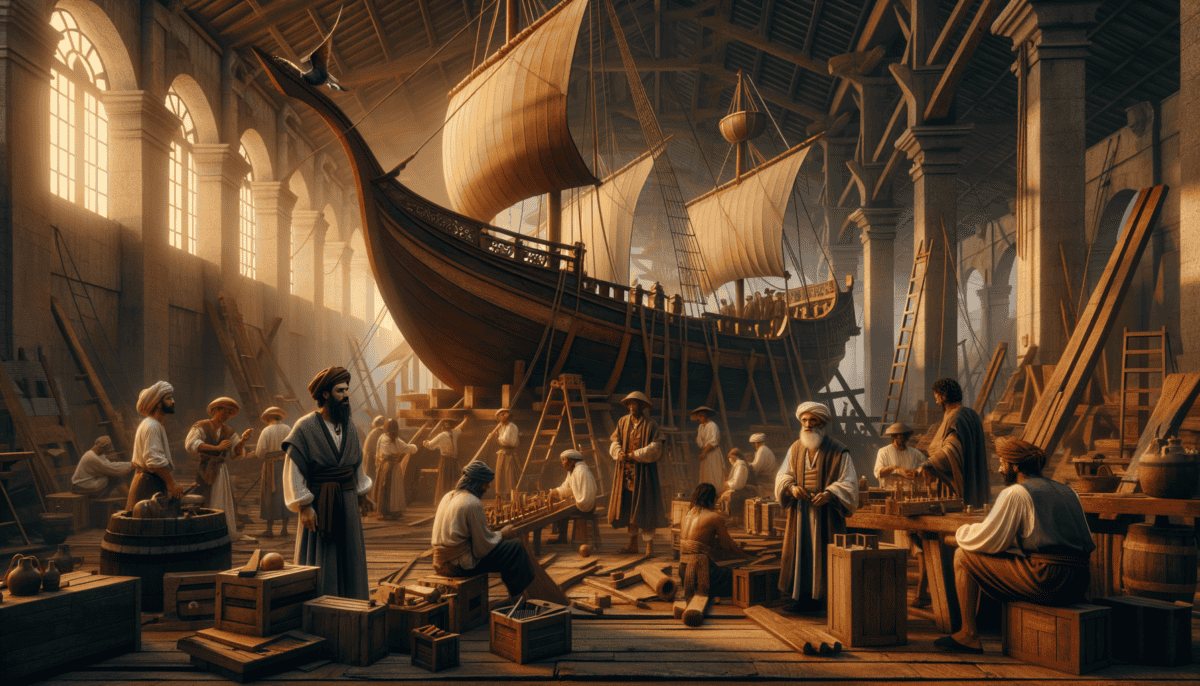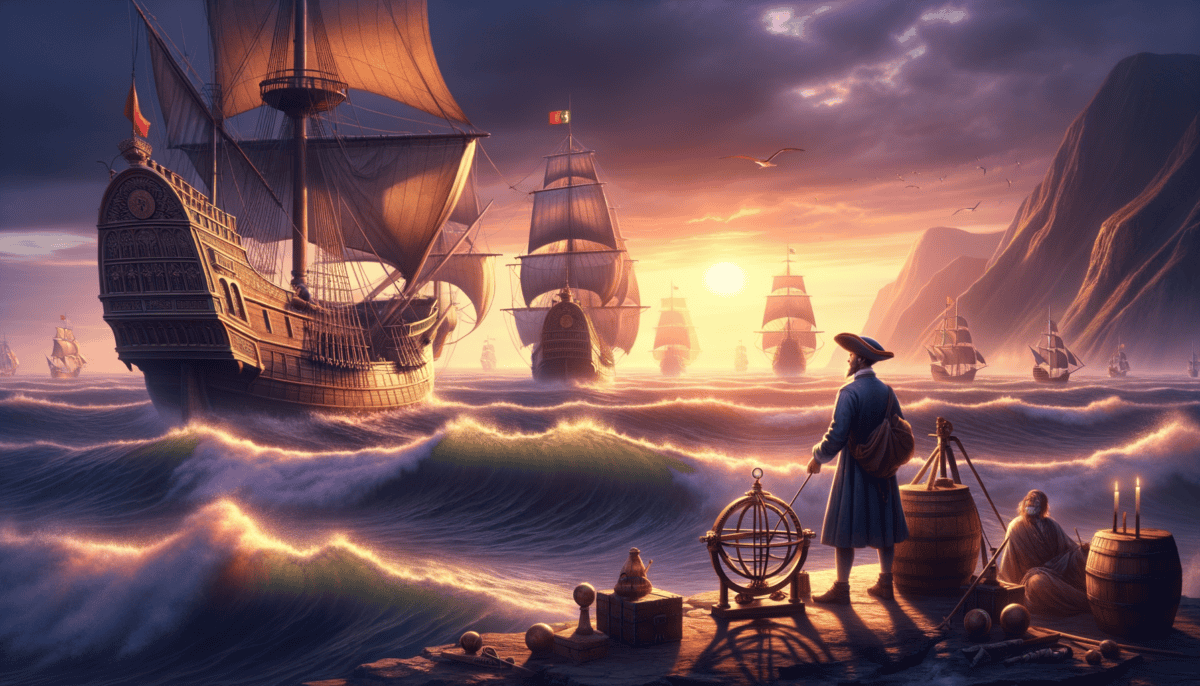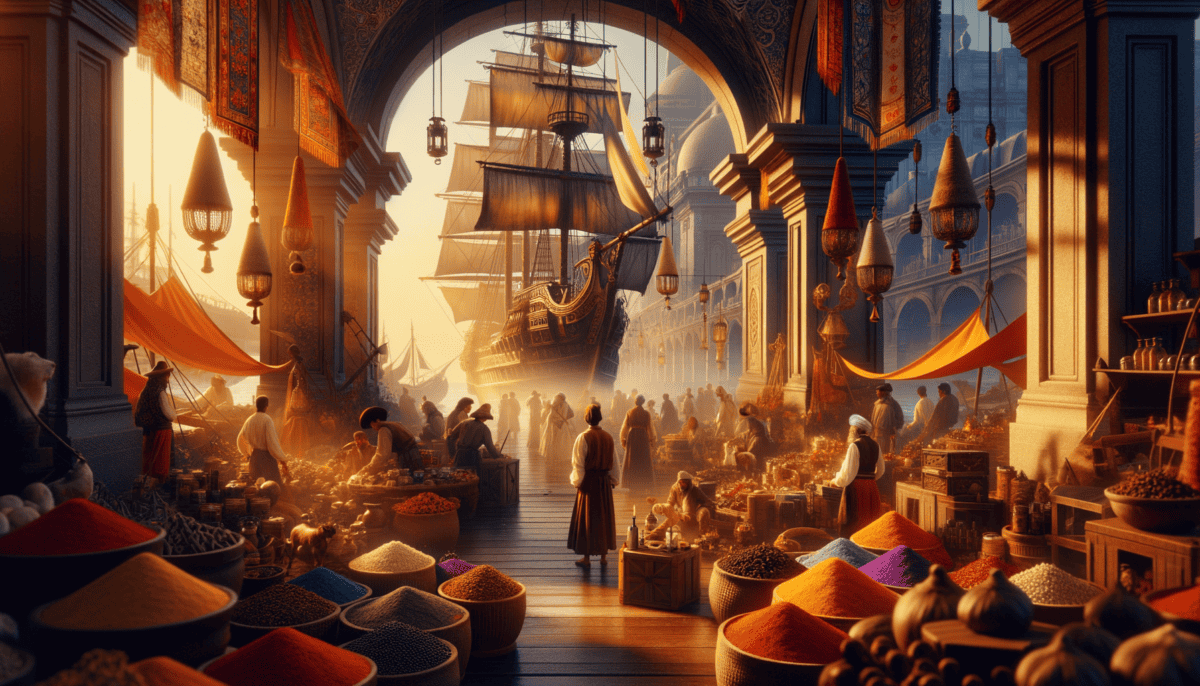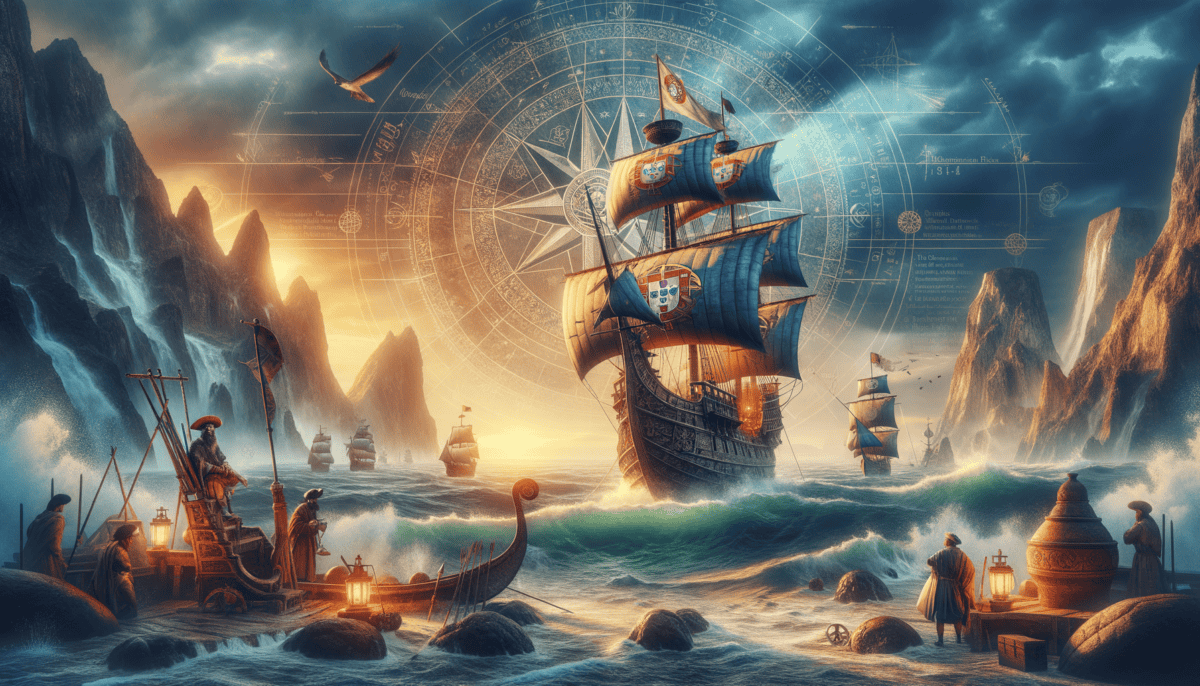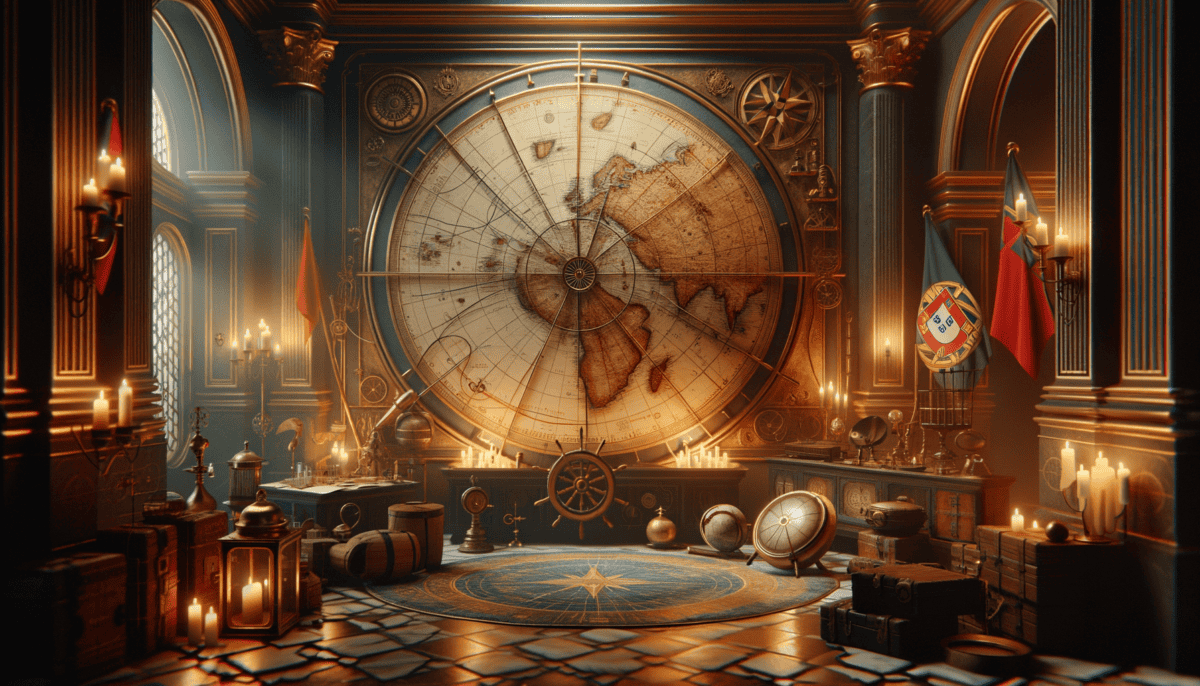A Young Prince’s Vision
The sun rose over the cliffs of Sagres, Portugal, where young Prince Henry stood gazing at the vast ocean. It was the year 1415, and the waves crashed against the rocks below, sending salty spray into the air.
"There must be more beyond the horizon," Henry whispered to himself, his eyes fixed on the endless blue waters.
Prince Henry wasn't like other princes who dreamed of fighting battles on land. His dream was different – he wanted to discover what lay across the great ocean. At just 21 years old, he had a big idea that would change the world forever.
In those days, most people were scared to sail too far from land. They believed scary monsters lived in the ocean, and ships would fall off the edge of the world! But Henry knew better.
"Your Highness," called out João Fernandes, one of his trusted advisors. "The new maps have arrived from Italy."
Henry rushed to his study room at the School of Navigation he had built right on the cliffs. The room was filled with:
- Maps drawn on soft leather
- Strange tools for measuring stars
- Books about far-away lands
- Reports from brave sailors
"Look here," Henry pointed to the African coast on a map. "If we can sail down this coast, maybe we can find a way to reach the lands of spices and gold!"
The prince spent his days talking to sailors and map makers. He listened to stories about distant shores and drew better maps. Some people thought he was silly to spend so much money on boats and maps.
“The ocean is too dangerous!” they would say. But Henry would smile and reply, “The greatest danger is never trying at all.”
In his special school, Henry taught sailors how to use the stars to find their way. He helped build better ships called caravels that could sail against the wind. These ships were amazing – they were like the spaceships of their time!
Little by little, Portuguese ships sailed further down the African coast. Each journey taught them something new. Henry would get so excited when sailors returned with stories about new lands and peoples they had met.
One evening, as the sun set over Sagres, Henry wrote in his diary:
"Today our ships reached further south than ever before. Soon we will find the way around Africa. I can feel it in my heart – Portugal will open the doors to a new world."
The sailors shared stories of their adventures in the taverns of Sagres. "Prince Henry's ships are the finest in the world," they would boast. "We're not afraid of sea monsters anymore!"
As night fell over Portugal, Henry would often stand at his window, watching the stars that guided his ships. He didn't know it yet, but his dream would soon grow bigger than he ever imagined. Portuguese ships would sail to places no European had ever seen before.
The candles flickered in Henry's study as he planned the next voyage. Tomorrow would bring new adventures, new challenges, and maybe, just maybe, the discovery of a path to the amazing lands of spices and gold that everyone talked about.
Prince Henry's dream was just beginning, and it would change not just Portugal, but the whole world. The great Age of Discovery was about to unfold, all because one young prince dared to dream about what lay beyond the horizon.
Masters of the Waves
The salty breeze whistled through the shipyard of Lagos, where master carpenter Miguel stood proudly beside his newest creation. It was 1441, and something amazing was happening – the birth of a new kind of ship called the caravel.
“Look how she curves like a bird’s wing,” Miguel explained to his young apprentice João. “This ship will dance with the winds instead of fighting them.”
The caravel was special because:
- It could sail against the wind
- It was faster than old ships
- It could carry lots of food and water
- It was easier to steer
- It could sail in shallow water
All around the shipyard, hammers rang out and saws buzzed through wood. Skilled workers shaped tall masts and strong hulls. The air smelled of fresh pine and tar.
“A ship is only as good as the hands that build her,” Miguel always said. “Each nail and plank must be perfect.”
In a nearby school, Captain Pedro taught young sailors how to use new tools:
The Astrolabe – A shiny metal circle that helped sailors find their way using stars ⭐
The Compass – A magical needle that always pointed north
New Maps – Better than the old ones, showing more of the coast ️
“Remember,” Captain Pedro would say, “the sea can be your friend or your enemy. It depends on how well you learn these lessons.”
One morning, a group of excited sailors gathered at the dock. They were about to test the new caravel on its first long journey.
“What if we get lost?” worried a young sailor named Rui.
The captain smiled. “We have better maps now, and we know how to read the stars. Portugal’s sailors are becoming the best in the world!”
The first test voyage was amazing! The caravel sailed faster than any ship before. It could turn quickly and didn’t need as many sailors to control it.
“Dear Diary,” wrote João that night, “Today I saw the future of sailing. Our new ships can go anywhere!”
Back in the royal palace, Prince Henry got the good news. “The caravel works even better than we hoped!” reported Miguel. “We can now sail further than ever before.”
People from other countries started coming to Portugal to learn about the new ships. Portuguese sailors became famous for their skills.
“Why are your ships so special?” they would ask.
“Because,” Miguel would answer with pride, “we put our hearts into building them. Each caravel carries the dreams of Portugal with it.”
As the sun set over Lagos harbor, more caravels were taking shape. Each one would be stronger and better than the last. These amazing ships would soon carry brave Portuguese sailors to places they had only dreamed about.
The tools were ready, the ships were strong, and the sailors were trained. Now it was time for Portugal to take the next big step in their great adventure. The world was waiting to be discovered, and Portugal had built the perfect ships to find it.
On the horizon, dark clouds were gathering. New challenges lay ahead, but with their amazing caravels and skilled crews, Portuguese sailors were ready to face any storm that came their way.
Crossing New Horizons
The year was 1497, and the bustling port of Lisbon buzzed with excitement. Vasco da Gama, a brave captain with bright eyes and a determined smile, stood on the dock looking at his fleet of four mighty ships.
“Today we sail for India,” he announced to his crew. “We will find a path no European has ever sailed before!”
The ships carried everything they needed:
- Food for 18 months at sea
- Special maps and tools
- Gifts for kings in new lands
- Brave sailors ready for adventure
- Medicine for sick crew members
As they sailed south along Africa’s coast, the weather got hotter and hotter. “Look!” shouted young sailor Manuel, pointing to strange fish jumping beside the ship. “I’ve never seen anything like them!”
“Each day brings new wonders,” Vasco wrote in his captain’s log. “The sea is full of secrets waiting to be found.”
But the journey wasn’t easy. Big storms tossed the ships like toys. Some sailors got sick. Others became scared when they couldn’t see land for many days.
“Be brave,” Vasco would tell them. “We’re making history with every wave we cross!”
Finally, after months at sea, they reached the tip of Africa. No Portuguese ship had ever sailed these waters before. The waves were huge, and the winds were strong.
“The ocean is testing us,” said Vasco. “But we will not give up!”
As they sailed up the east coast of Africa, they met friendly traders who helped them. In Kenya, they found a guide named Ahmad who knew the way to India.
“The sea ahead is full of merchant ships,” Ahmad told them. “Follow the monsoon winds, and they will carry you to India.”
The crew was amazed by all the new things they saw:
Spices that smelled wonderful ️
Colorful fabrics they had never seen before
Strange animals like zebras and giraffes
After 23 days crossing the Indian Ocean, they finally saw India! The sailors cheered and hugged each other. They had done what many thought was impossible.
“Welcome to Calicut,” said the harbor master. “You have come a very long way!”
In India, they found markets full of precious spices, beautiful silk, and sparkling gems. The Portuguese had found what they were looking for – a direct route to the riches of the East!
When Vasco and his crew returned to Portugal two years later, they were heroes. They had opened a new chapter in history. Now ships could sail all the way around Africa to reach India.
“This is just the beginning,” Vasco told King Manuel. “The sea roads are open, and Portugal will never be the same.”
That night, as stars twinkled over Lisbon harbor, new crews were already preparing their ships. More adventures waited on the horizon, and Portuguese sailors were ready to find them.
Trade Winds and Treasures
The sun rose over Lisbon’s harbor, now bustling with more ships than ever before. Portuguese sailors rushed about, loading crates of cinnamon, pepper, and silk onto their vessels.
“Look at all these wonderful things!” young Maria exclaimed, watching workers carry bright cloth and sweet-smelling spices. Her father, Captain João, smiled proudly.
“Yes, little one. Our brave sailors bring these treasures across the big oceans.”
“The whole world comes to our doorstep now,” whispered Maria, eyes wide with wonder.
Portugal built special places called trading posts along the sea routes. These were like tiny pieces of Portugal in faraway lands. Here are some important trading posts they made:
- Goa in India – The biggest and most important
- Malacca in Malaysia – Where ships got spices
- Macau in China – For trading silk and tea
- Hormuz in the Persian Gulf – Called the “Pearl of the Indies”
- Mozambique in Africa – A safe stop for ships
Captain João walked with Maria through the market. “See how our city has changed? We have people from all over the world living here now!”
He was right. The streets were full of different faces, clothes, and languages. Merchants from India wore colorful turbans. Chinese traders sold delicate porcelain. African musicians played new kinds of music.
“But Papa,” Maria said, “I heard other countries want to find these trade routes too.”
João nodded seriously. “Yes, Spain, England, and Holland all want to sail to India now. We must work hard to keep our sea routes safe.”
Portuguese ships got better and stronger. They carried big guns to protect themselves from pirates. The sailors learned to use the wind patterns called “trade winds” to sail faster.
“Our ships are like floating cities,” a sailor named Miguel told Maria. “We carry food, doctors, soldiers, and traders. Sometimes we’re at sea for many months!”
New things came to Portugal:
Sweet oranges from China
Soft cotton from India
Shiny pearls from the Persian Gulf
But trading wasn’t always easy. Storms could sink ships full of treasures. Sometimes other countries’ ships would try to steal the cargo.
“It’s worth the risk,” Captain João said. “These trades make Portugal rich and powerful. We learn so much from the people we meet.”
One evening, Maria sat with her father watching ships come into the harbor. Their sails glowed orange in the sunset.
“Papa, will you teach me about the stars and winds? I want to be a ship captain too!”
João laughed and hugged her. “Of course! Maybe someday you’ll find new routes and treasures we haven’t even dreamed of yet.”
As night fell over Lisbon, more ships prepared to sail out. The age of trade was in full swing, and Portugal led the way. New adventures and discoveries waited just over the horizon.
Dreams of Global Adventure
A young boy named Fernando stood at the docks of Lisbon, watching a familiar ship return. Its sails were torn, but the crew walked proudly. They had just finished sailing all the way around Africa!
“Uncle Magellan!” Fernando called out, waving excitedly. “You’re back!”
Ferdinand Magellan smiled at his nephew. His face was tanned from many days at sea. “Indeed I am, little explorer. And I have bigger dreams than ever.”
“Tell me about your plan,” Fernando begged, sitting with his uncle near the harbor.
Magellan pulled out a worn map. “Look here. If we sail west instead of east, we might find a new way to reach the Spice Islands.”
“But won’t you fall off the edge of the world?” Fernando asked nervously.
Magellan chuckled. “The world is round, my boy. Like an orange. We can sail all the way around it!”
Getting ready for such a big trip wasn’t easy. Magellan needed:
- Five strong ships
- Lots of food and water
- Smart sailors who could read the stars ⭐
- Brave people willing to try something new
- Special tools for finding the way
“The King of Portugal said no to my plan,” Magellan told Fernando sadly. “But the King of Spain said yes!”
On September 20, 1519, the ships set sail. Fernando watched them leave, waving goodbye to his brave uncle.
The journey was very hard. They sailed through big storms and across empty oceans. Some sailors got sick. Food went bad. But Magellan kept going.
They found amazing things:
A narrow path through South America (now called the Strait of Magellan)
A huge ocean they named the Pacific because it seemed peaceful
New islands with friendly people
Strange animals they had never seen before
Sadly, Magellan didn’t make it home. He died in a fight on an island. But one of his ships, the Victoria, kept going.
Three years after leaving, the Victoria sailed back into Spain. Only 18 of the original 270 sailors made it home. But they had done something amazing – they proved people could sail all the way around the world!
Years later, Fernando stood at the same dock, now a grown man. He looked out at the sea and remembered his uncle’s dream.
“You did it, Uncle,” he whispered. “You showed us the whole world was connected by the sea.”
The sun set over Lisbon harbor, painting the sky orange and pink. Somewhere out there, more adventures waited for brave sailors willing to chase their dreams.
More ships were getting ready to sail. They would follow the path that Magellan found, carrying goods and ideas around the whole world.
A World Forever Changed
Little Maria sat on her grandfather’s lap in modern-day Lisbon, looking at an old painting of ships in the harbor. The same harbor she could see from their window!
“Grandpa, tell me again how Portugal changed the world,” she asked, pointing to the ancient sailing vessels.
“Ah, minha querida,” he smiled, “those brave sailors from long ago connected the whole world for the first time.”
• New foods like tomatoes and potatoes came to Europe
• People learned about different cultures and languages
• Maps showed the whole world for the first time
• Ships could sail anywhere on Earth
• Trading became easier between far-away places
Maria’s eyes grew wide. “And it all started right here?”
“Yes, right here in Portugal. Prince Henry had a dream. Brave sailors built better ships. They found new ways to sail far away.”
“The Portuguese were the first to show that all the oceans are connected,” Grandpa explained. “Like one big blue blanket wrapped around Earth.”
He pulled out his phone and showed Maria pictures of things the Portuguese discovered:
Beautiful spices from India ️
Silk from China
Gold from Africa ✨
“But the best discovery,” Grandpa said, “was learning that people everywhere are more alike than different.”
Maria looked thoughtful. “Like my best friend Lin? Her family came from China!”
“Exactly! Portuguese sailors helped show that we’re all part of one big world family.”
– Portuguese words in many languages
– Foods that traveled around the world
– Cities built by Portuguese traders
– Maps and sailing tools they invented
“The spirit of those brave explorers lives on,” Grandpa said. “Now we explore space! And scientists explore tiny things we can’t even see! “
Maria jumped up excitedly. “Maybe I’ll be an explorer too!”
Grandpa hugged her tight. “You already are, minha querida. Every time you learn something new or meet someone different, you’re exploring!”
They watched modern ships entering the harbor as the sun set. The same harbor where Prince Henry once dreamed, where Vasco da Gama set sail for India, and where Magellan began his journey around the world.
“Remember,” Grandpa said softly, “the greatest journeys start with curiosity and courage – just like those first Portuguese explorers.”
Maria nodded, already dreaming of her own adventures. Because that’s what Portugal’s story teaches us – dreams can change the world, one brave journey at a time.
The story of Portugal’s golden age of exploration might be in the past, but its spirit of discovery lives on in every curious heart and brave soul who dares to explore something new.


